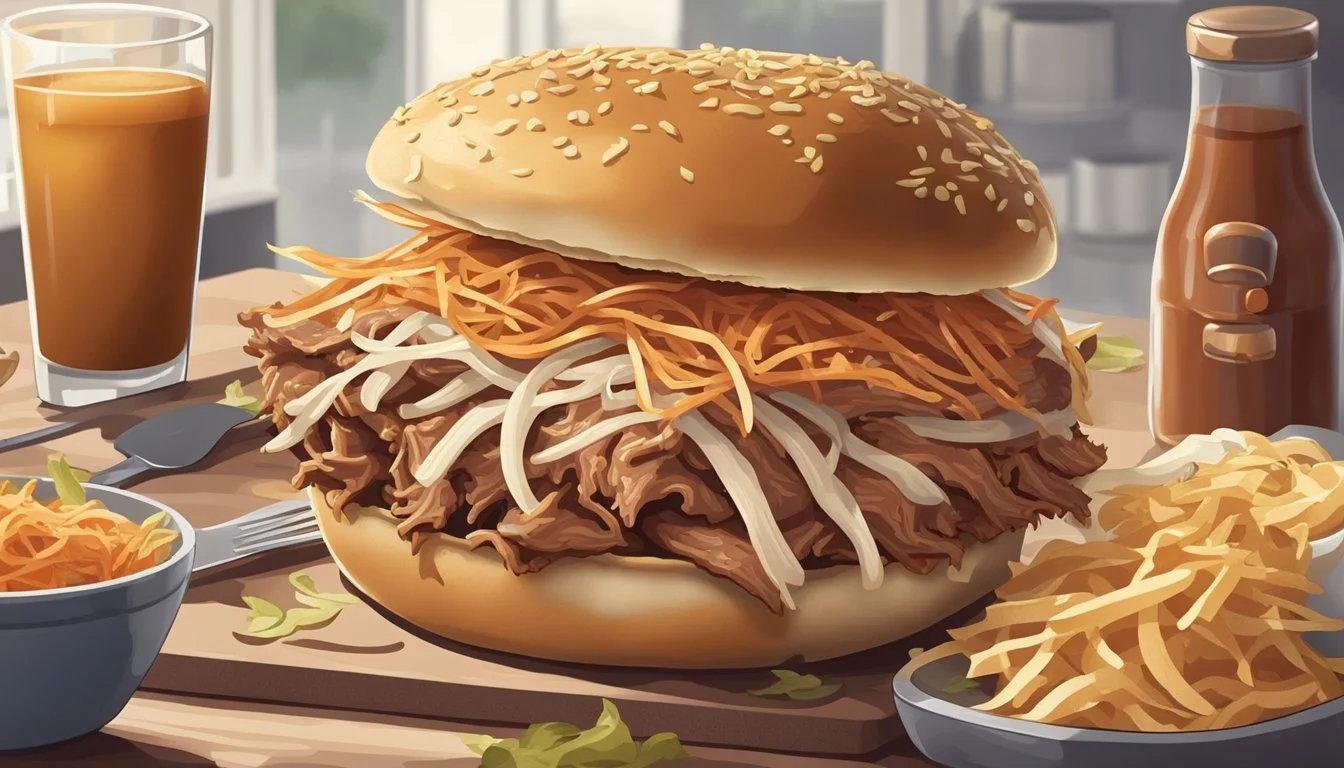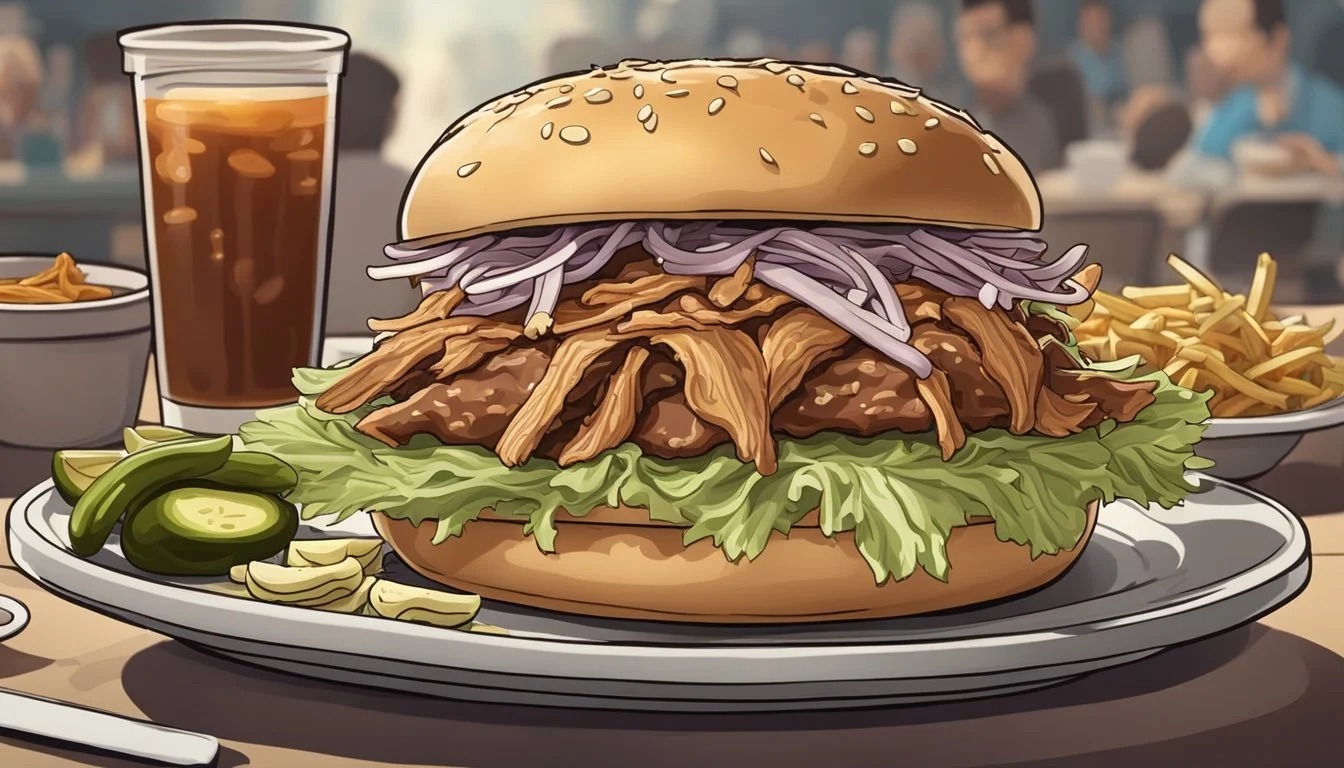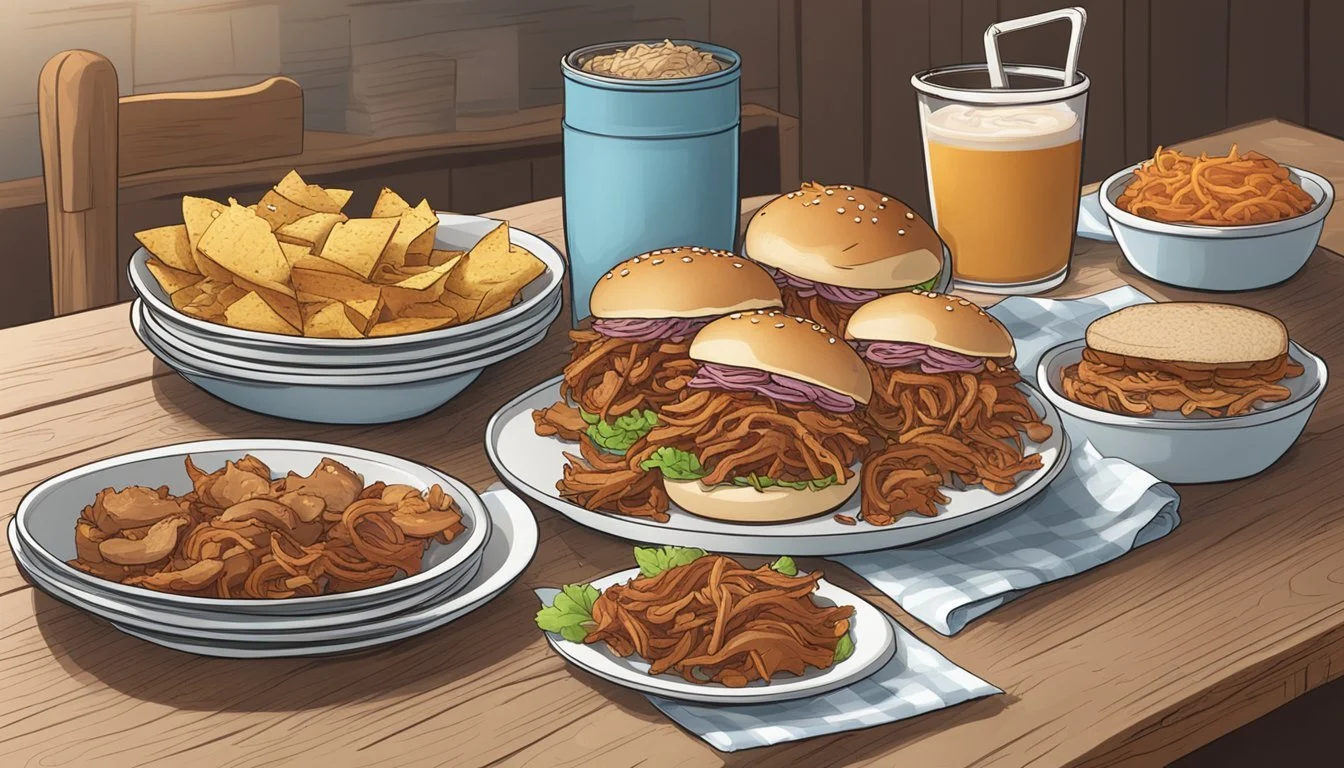North Carolina: The Pulled Pork BBQ Sandwich Challenge
A Gastronomic Battle Worth Tasting
North Carolina is renowned for its distinct take on barbecue (What wine goes well with barbecue?), particularly its specialization in savory, slow-cooked pulled pork. The state takes pride in a rich tradition of smoked meats (What wine goes well with smoked meats?), and the pulled pork BBQ sandwich sits at the heart of this culinary culture. A reflection of the regional dedication to flavor and technique, the pulled pork BBQ sandwich is not just a dish; it's a testament to North Carolina's heritage and commitment to the craft of barbecue.
The love for this delicacy has given rise to a mouthwatering challenge: finding the ultimate BBQ pulled pork sandwich within the state’s borders. Enthusiasts and foodies alike partake in this endeavor, each establishment offering their own version of the iconic sandwich. Cooked for hours until it reaches fall-apart tenderness, the pork is then tucked into a soft bun and often topped with a tangy vinegar-based slaw, pairing perfectly with the smoky, rich meat.
While exploring this challenge, the interplay of textures and flavors is key. Each bite offers a complex blend of smokiness, sweetness, and acidity—characteristics that define the North Carolina BBQ tradition. It's a culinary journey that not only invites one to savor the state's storied barbecue but to delve into its communal and historic roots spread among local pitmasters and smokehouses.
The History of North Carolina BBQ
North Carolina's barbecue heritage is deeply entwined with its history and cultural identity, characterized particularly by its pork-based barbecue traditions and the unique styles that have emerged within the state.
Origins and Cultural Significance
Barbecue in North Carolina originated from Native American and European settlers' cooking practices, with the whole hog being cooked over a wood fire for hours. This cooking method has become a symbol of state pride and reflects the state's agricultural history. Pork, specifically, gained prominence due to the abundance of pigs in the region, which made it the meat of choice for barbecue.
Vinegar sauce, a quintessential component of traditional North Carolina barbecue, showcases a tangy flavor that complements the fatty richness of the pork. The sauce's simplicity, often a mixture of vinegar, spices, and sometimes a hint of tomato, speaks to the historical scarcity of resources and the need to preserve meat with available ingredients.
Styles of North Carolina BBQ
In North Carolina, there are two primary styles of barbecue, differentiated mainly by their geographic roots within the state:
Eastern style: Involving the whole hog, this style is known for its use of a vinegar and pepper-based sauce. This traditional approach is reflective of the earliest methods of barbecue in the state.
Western style (often referred to as Lexington style): This style primarily uses the pork shoulder and is associated with a "dip" that includes vinegar sauce sweetened with tomato ketchup.
These styles are not just culinary preferences but also represent the local identities and traditions within North Carolina. They serve as gathering points at community events and family functions, reinforcing the social fabric and continuing the legacy of North Carolina Barbecue.
Selecting the Right Cut
When it comes to North Carolina Pulled Pork BBQ, selecting the right cut of pork is crucial. It is the starting point for a succulent, flavorful sandwich that pays homage to the state's barbecue tradition.
Types of Pork Cuts for BBQ
For authentic North Carolina Pulled Pork BBQ, pork shoulder is the staple choice. It’s divided into two main cuts: the Boston Butt and the Picnic Shoulder. The Boston Butt is the upper part of the shoulder, rich in fat and connective tissue, which renders down during cooking to create tender, flavorsome meat. Conversely, the Picnic Shoulder is leaner, extends down to the foreleg, and has a slightly different texture, making it a less traditional but still viable option for BBQ.
Bone-In Vs. Boneless Pork Shoulder
The debate between bone-in versus boneless pork shoulder pertains to flavor and convenience. A bone-in pork shoulder typically imparts a deeper flavor and ensures the meat stays moist, while the bone itself can be used as a natural conductor of heat. However, the boneless cut offers easier carving and more uniform cooking times. For competitive barbecue, including North Carolina's Pulled Pork challenges, the bone-in version is often preferred for the complex flavor profile it can potentially yield to the meat.
Preparation of the Pulled Pork
Crafting the perfect North Carolina-style pulled pork sandwich requires meticulous preparation steps, starting from seasoning the meat to ensuring that each strand is imbued with succulent flavors.
Seasoning and the Dry Rub
The foundation of flavor for pulled pork begins with a dry rub. Essential ingredients such as salt, paprika, and brown sugar are mixed to create a balanced blend that complements the natural richness of the pork. They typically rub the mixture thoroughly onto the surface of the meat, ensuring each nook is well-covered.
Common Dry Rub Ingredients:
Salt: Ensures basic seasoning
Paprika: Adds a smoky nuance
Brown Sugar: Provides sweetness and a caramelized crust
Marinating Techniques
While some pitmasters may bypass marinating in favor of a robust rub, others incorporate liquids like cider vinegar or maple syrup to further tenderize the pork and add depth to its flavor profile. Marinating time can vary, but many recipes suggest several hours or overnight to achieve maximum absorption.
Marinating Solutions Could Include:
Cider Vinegar: For tanginess and tenderizing
Maple Syrup: For sweetness and glazing properties
The Role of Brining
Brining is a technique employed to infuse the pork with moisture, using a solution of vinegar, sugar, and additional seasonings like black pepper. This step can greatly enhance the juiciness of the meat and is often considered crucial for achieving the desired tenderness throughout the slow-cooking process.
Typical Brining Solution:
Vinegar & Water (50/50 mix)
Sugar & Salt: Usually in a 1:1 ratio to water by volume
Spices: Black Pepper, and others based on preference
By adhering to these detailed preparation steps, they set the stage for pulled pork that is rich in taste, tender to the fork, and authentically North Carolinian.
Cooking Methodology
When it comes to North Carolina's famed pulled pork BBQ sandwiches (What wine goes well with sandwiches?), the cooking methodology is crucial. Different techniques impact the flavor and texture of the pork, each method bringing its own signature to the table.
Grilling Vs. Smoking
Grilling involves cooking the meat quickly over a high heat source, usually direct flames. This method can impart a charred, smoky flavor to the meat, especially when a Charcoal Grill or Gas Grill is used. On the other hand, smoking is a much slower process, typically done in appliances like the Big Green Egg, where the pork is exposed to smoke from smoldering wood chips such as Oak or Hickory to achieve a deep, rich smokiness.
Managing Heat and Smoke
The key to successful smoking is managing the heat and smoke to maintain a consistent temperature. One must be meticulous; too much smoke can overwhelm the meat, giving it a bitter taste, while too little may not imbue it with the desired smoky flavor. Techniques include controlling the airflow with vents in a Charcoal Grill or using a water pan in a smoker to stabilize temperature.
Using Different Types of Wood
Different types of wood can dramatically alter the flavor profile of the pork. Hickory is a classic choice that imparts a strong, smoky taste synonymous with Southern BBQ, while Oak is more subtle and can be used for a longer smoking process without overpowering the meat. Hickory Chips are widely used, and the type of wood chosen should complement the pork and any seasonings or sauces.
Internal Temperature and Resting the Meat
Achieving the perfect Internal Temperature is essential for tender, succulent BBQ pork. It should reach about 200°F to break down the connective tissues properly. Once the meat hits the target temperature, it's important to let it rest. Resting allows the juices to redistribute throughout the meat, ensuring that the pulled pork is moist and flavorful.
Using a reliable meat thermometer is vital to monitor the Internal Temperature closely.
Building the Sandwich
Constructing the iconic North Carolina pulled pork BBQ sandwich involves careful consideration of the bread, a generous layering of succulent pulled pork slathered in tangy sauce, and distinct toppings that contribute to its authentic flavor.
Choosing the Right Bun
For a sturdy foundation, the ideal bun should balance softness with durability to hold up against the juicy pork and sauce. Hamburger buns with a light yet firm texture are widely favored, preventing the sandwich from becoming soggy.
Layering the Pulled Pork and Sauce
The star of the sandwich, Carolina pulled pork, is slow-roasted until tender, embodying a rich smokiness. It's customary to layer a heaping portion onto the bun, which is then generously doused with a vinegar-based BBQ sauce, giving it its characteristic tang and zest.
Toppings and Condiments
To finish, cole slaw and pickles are classic accompaniments that add crunch and contrasting flavors. While some purists might stick to these staples, others may introduce a hint of ketchup or alternative barbecue sauces to customize their sandwich to their palate.
Sauces and Flavorings
In North Carolina, BBQ sauce is a defining feature of the pulled pork sandwich, with variations playing a crucial role in taste and preference.
Vinegar-Based Versus Tomato-Based Sauces
In North Carolina, vinegar-based sauce is a hallmark, especially in the eastern part of the state. It often includes a blend of cider vinegar, water, and red pepper flakes or crushed red pepper, providing a tangy and spicy profile that penetrates the meat. In contrast, some prefer a tomato-based sauce, which integrates ketchup or tomato with vinegar, creating a sweeter and thicker consistency.
The Heat Element: Spices and Peppers
The level of heat in a BBQ sauce can vary significantly. Crushed red pepper and red pepper flakes are common ingredients to introduce a fiery kick, which complements the savory aspect of the meat. The heat is often balanced with brown sugar or maple syrup, which lend a mild sweetness to offset the spiciness.
Sweet and Tangy: Balancing Flavors
The art of BBQ sauce is in the balance of flavors. Sweet elements such as brown sugar, honey, or maple syrup counter the acidity from vinegar and the savory notes from ingredients like Worcestershire sauce. This sweet and tangy dynamic is essential to a well-rounded vinegar sauce, making the pulled pork both rich and refreshing.
Serving and Presentation
In North Carolina, the art of serving a Pulled Pork BBQ Sandwich goes beyond mere arrangement on a plate. Every component, from the choice of bun to the garnishes, plays an essential role in crafting the perfect barbecue experience.
Garnish and Side Dishes
Garnish:
Coleslaw: A spoonful of coleslaw atop the pork adds a crunchy contrast.
Pickles: Dill or bread-and-butter pickles bring a tangy acidity that cuts through the richness.
Side Dishes:
Classic sides often include:
Hushpuppies: Golden and crispy, they are a staple companion.
Mac and cheese: Creamy and rich, it offers a comforting balance.
Baked beans: Smokey and sweet, they complement the savory pork.
Plating Techniques for the Pulled Pork Sandwich
Bun:
A toasted and buttered bun is key; it should be sturdy enough to hold the pork and the sauces without falling apart.
Building the Sandwich:
Start with a generous mound of pulled pork on the bottom bun half.
Drizzle with vinegar sauce infused with red pepper for a hit of spiciness.
If preferred, a dab of traditional barbecue sauce adds a sweet and smoky note.
When possible, allow guests to add their own sauces to tailor the sandwich to their taste.
Presentation should be simple, letting the vibrant colors and textures of the ingredients shine. A clean cut through the sandwich may expose the tender pork layers, while the side dishes are typically served in separate ramekins or on a shared platter for family-style dining.
Nutritional Information
When assessing the nutritional profile of a North Carolina pulled pork barbecue sandwich, it's essential to consider the core components: the pork, the barbecue sauce, and the bun. A standard serving of this beloved sandwich typically contains 532 calories, with variations depending on the recipe and portion size. Here is a simple breakdown of the primary nutritional content for a standard serving size:
Calories: 532
Total Fat: 7.5g (10% Daily Value)
Saturated Fat: 2.2g (11% Daily Value)
Protein: Generally, around 35g, which contributes to the sandwich's satisfying nature.
Notably, pulled pork is known for its moist and tender texture, which is achieved through slow cooking. However, the moisture level can affect the calorie content, as fattier cuts may yield a more succulent bite but also increase the fat content.
For those with dietary considerations, it's important to note that a pulled pork BBQ sandwich may not align with low-fat or low-calorie diet plans due to its caloric density and fat content. Additionally, variations like adding coleslaw or cheese can increase both the caloric and fat values. Here's an example of how extra toppings can contribute:
With Coleslaw: Adds approximately 100-150 calories.
With Cheese: Adds around 50-100 calories, depending on the type and amount.
In summary, the pulled pork sandwich is a hearty choice, best enjoyed in moderation within a balanced diet. Those monitoring their intake for health or dietary reasons should consider portion size and toppings to stay aligned with their nutritional goals.
Hosting a Pulled Pork Sandwich Event
When planning a Pulled Pork Sandwich Event, a host must consider how to efficiently serve a crowd and offer a memorable do-it-yourself (DIY) experience. Whether the event showcases regional variations like those celebrated in United Sandwiches of America or focuses on the traditional barbecue flavors of North Carolina, attention to detail will make all the difference.
Catering for a Crowd
To effectively cater to a crowd, the host should determine the amount of food based on the number of attendees. A common rule is to plan for about 1/2 pound of pulled pork per person. Prep sides such as coleslaw and cornbread well in advance and offer a variety of condiments to complement the rich flavors of barbecue.
Pulled Pork Estimates
Number of Guests: 50
Amount of Pork: 25 pounds
Sides (for 50 guests)
Coleslaw: 10 pounds
Cornbread: 60 pieces
It's also important to consider dietary restrictions and provide alternative options for those who may not eat pork.
DIY Sandwich Bar Setup
For the DIY Sandwich Bar, organization is key. Arrange the table in a logical flow with plates and utensils at the front, followed by the pulled pork, buns, and an array of toppings. Signage can assist guests in creating their own perfect sandwich. Here is an example of how to set up the bar:
Plates & Utensils
Pulled Pork
Keep the pork warm in chafing dishes
Buns
Offer different types: classic, whole wheat, gluten-free
Toppings & Condiments
Onions, pickles, jalapeños
North Carolina vinegar sauce, mustard sauce, and other barbecue favorites
Having a designated sandwich-making space encourages guests to get creative while also enabling better crowd management. Consider offering a basic recipe card to guide those less familiar with constructing the ultimate pulled pork sandwich.
Clean-up and Food Safety
In the process of enjoying a North Carolina Pulled Pork BBQ Sandwich, it's crucial to address the aftermath with attention to food safety and orderly clean-up. This section meticulously guides on the proper handling of leftovers to avoid foodborne illnesses and the disposal of cooking waste to maintain sanitation.
Proper Handling of Leftovers
Once the feasting is over, leftovers should be treated with care. They ought to be packed and stored in shallow containers to expedite cooling. The ideal storage temperature for leftovers is at or below 40 degrees Fahrenheit, and food should be refrigerated within two hours of cooking to prevent bacterial growth. Using aluminum foil or plastic wrap ensures the leftovers are well-covered.
Tip: Clearly label leftovers with the date before storing to keep track of their freshness.
Disposal of Cooking Waste
Managing cooking waste is just as important as handling food correctly. When discarding cooking liquid, such as mop sauce or marinades, ensure it goes directly into the sink to avoid spills, which can be a slipping hazard.
Rubber gloves can be worn for dirty tasks to protect the skin from irritants and to maintain hygiene. If any cooking waste includes remnants of fat or bones, a cleaver may be necessary to break down the waste before placing it in a heavy-duty garbage bag.
Cooking Tips:
Use a separate cutting board for cooked and raw meats to avoid cross-contamination.
Clean all cooking surfaces and tools with hot, soapy water after use, or consider using a solution of bleach and water to sanitize areas that have come into contact with raw meat.
Through these measures, you ensure both delicious meals and a clean, safe environment.
Related Culinary Techniques
Exploring the culinary techniques related to North Carolina's pulled pork BBQ sandwich unveils a variety of alternative recipes and innovative uses for pulled pork in other dishes. Mastery of these methods enhances the versatility of pork and broadens a cook's repertoire.
Alternative BBQ Recipes
Barbecue enthusiasts often experiment with different meats to achieve unique flavors and textures. Chicken and beef are popular alternatives, each requiring its own specific seasoning blends and cooking times. For chicken, a blend of vinegar-based sauce with a hint of heat complements its lighter texture. Beef, particularly brisket, demands a robust rub and a longer smoking process to reach the desired tenderness.
Recipes may also call for non-traditional BBQ items like chickpeas, which, when seasoned and slow-cooked, can provide a vegetarian twist to BBQ dishes. These can be blended using a blender or food processor to create dips and spreads that carry the essence of BBQ flavors.
Using Pulled Pork in Other Dishes
Pulled pork's versatility allows it to be a star ingredient in numerous other dishes. It can be integrated into pork recipes such as enchiladas or stirred into a hearty chili. One can also layer it on gourmet pizzas or mix into macaroni and cheese for a rich, comforting meal.
Tacos: Pulled pork makes an excellent filling for tacos, topped with fresh salsa and a squeeze of lime juice.
Salads: For a lighter fare, tossing pulled pork with greens, roasted corn, and black beans offers a BBQ-infused salad.
Soups: A flavorful pulled pork soup with potatoes and vegetables is a perfect way to repurpose leftovers.
Through these techniques, the flavor profiles of North Carolina's pulled pork BBQ can transcend the sandwich and inspire a diverse range of culinary creations.
Conclusion
The expedition through North Carolina's barbecue landscape reveals the Pulled Pork BBQ Sandwich Challenge as not only a test of one's appetite but a journey through a rich tapestry of taste and tradition. The satisfaction of the palate is nearly guaranteed, with each establishment offering a unique take on the iconic sandwich.
North Carolina Pulled Pork is the cornerstone of this challenge. It's the meticulous blend of smoky, savory, and a hint of vinegar tang that sets the North Carolina-style apart. Countless connoisseurs have hailed this regional variant for its careful balance of flavors that cater to an array of taste preferences.
Participants in the BBQ Sandwich Challenge are often astounded by the variety and depth of flavors wrapped in a bun. From the classic vinegar-based mops to the subtle twist of local spices, they discover that each bite offers a window into the culinary soul of the region.
In reflection, this gastronomic quest does more than satiate hunger: it pays homage to a beloved cuisine, entwining the participants with the fabric of North Carolina's barbecue culture. They leave, not only with a satisfied palate but with an appreciation for the culinary artistry that is the North Carolina Pulled Pork BBQ Sandwich.









